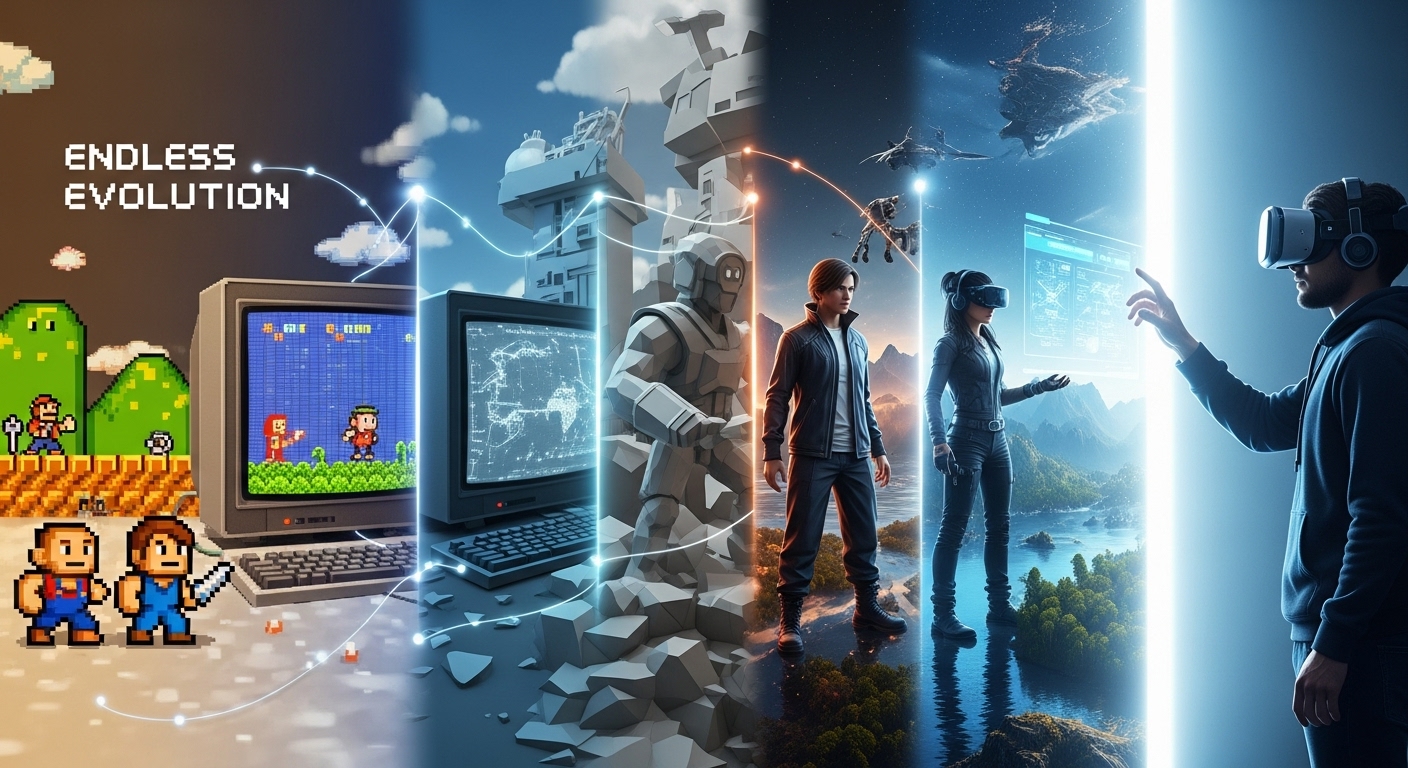Introduction: The Phenomenon of Gaming
Video games have evolved from being a niche hobby to a dominant force in global entertainment, transcending generations and cultures. Once considered a pastime for kids and geeks, gaming has now become a cultural cornerstone, influencing everything from technology and art to storytelling and social interaction. The video game industry today is worth billions of dollars and attracts millions of players, from casual mobile gamers to hardcore esports competitors.
But this wasn’t always the case. To understand where gaming stands today, we must first look at where it all began and explore the transformative journey that has turned video games into a vital and influential part of modern life. In this blog, we’ll examine the key milestones in the history of gaming, its impact on society, and what the future holds for the ever-evolving world of interactive entertainment.
The Early Days: Pioneering the Industry
The Birth of Video Games
Though we often associate the beginning of video games with the 1970s, the origins of video games can be traced back to the 1950s and 1960s, when scientists and engineers first began experimenting with interactive electronic entertainment. The first known video game, Tennis for Two, was created by physicist William Higinbotham in 1958. It was displayed on an oscilloscope and mimicked a simple tennis match, allowing two players to hit a ball back and forth. While Tennis for Two was limited in scope and purpose, it marked the birth of interactive entertainment.
The real breakthrough came in 1962 with the creation of Spacewar! by MIT student Steve Russell. Unlike earlier experiments, Spacewar! could be played on a computer and involved two players controlling spaceships, trying to shoot each other down while avoiding the gravitational pull of a star in the middle of the screen. This game is often considered the first true video game, and it inspired countless developers who would follow in its footsteps.
The Birth of Commercial Gaming
The first commercial video game machine, Pong, was created by Atari’s Nolan Bushnell in 1972. Simple, yet addictive, Pong simulated a two-player game of table tennis, with players using paddles to bounce a ball back and forth on a black-and-white screen. Pong was installed in bars and arcades, where it quickly became a hit. Its commercial success helped establish video games as an entertainment medium with mass appeal.
In the following years, arcade games exploded in popularity, with hits like Space Invaders (1978), Asteroids (1979), and Pac-Man (1980) becoming household names. The arcade era, as it came to be known, was characterized by players spending hours in arcades, competing for high scores and socializing with friends. The arcade was the first venue where gamers could interact with their favorite games on a scale never seen before.
The Rise of Home Consoles: Revolutionizing the Gaming Experience
The Introduction of Home Consoles
While arcade gaming was thriving, there was a growing demand for the ability to play games at home. The first major step toward home gaming came in 1972 with the release of the Magnavox Odyssey, the first home video game console. Although basic and lacking the advanced graphics of arcade machines, the Odyssey allowed players to connect to their television and play simple games like Table Tennis and Shooting Gallery. It was a humble beginning, but it proved that video games could be enjoyed in the home environment.
The 1980s witnessed a major shift in the home console market. The Nintendo Entertainment System (NES), launched in 1985, became a cultural phenomenon and single-handedly revived the home gaming industry after the video game crash of 1983. The NES was technologically advanced for its time and featured iconic titles like Super Mario Bros. and The Legend of Zelda. These games set the stage for the explosion of the gaming industry in the coming decades, offering players more engaging experiences with deeper gameplay, colorful graphics, and memorable characters.
At the same time, Sega introduced the Sega Genesis in 1988, which became Nintendo’s primary competitor during the 16-bit console era. With titles like Sonic the Hedgehog and Mortal Kombat, Sega gained a loyal following and began the console war rivalry that would define much of the 1990s.
The 3D Revolution and the Rise of PlayStation
Moving Beyond 2D: The Shift to 3D Gaming
The 1990s marked the beginning of the 3D revolution in gaming. As technology advanced, game consoles and PCs gained the ability to render 3D graphics, changing the way games were designed and played. 3D gaming opened up new possibilities, allowing players to explore vast, immersive worlds with a depth of experience previously unimaginable in 2D.
One of the key milestones in 3D gaming was the release of Super Mario 64 in 1996 for the Nintendo 64. This game was one of the first fully realized 3D platformers and introduced players to an open-world format where they could explore and interact with their environment in new ways. Super Mario 64 not only redefined the platformer genre but also set a new standard for 3D game design, influencing countless future titles.
At the same time, Sony launched the PlayStation in 1994, introducing a new era of gaming. The PlayStation’s power and use of CD-ROMs allowed developers to create larger, more complex games, leading to the development of titles like Final Fantasy VII (1997) and Gran Turismo (1997). Sony’s success with the PlayStation established it as a major player in the gaming industry, and the PlayStation brand remains a key force in the gaming world to this day.
The Emergence of Online Gaming
As the 1990s progressed, the internet began to play an increasing role in the gaming world. Initially, online gaming was confined to PC games, with titles like Quake (1996) and Unreal Tournament (1999) offering multiplayer modes that allowed players to compete against others over the internet.
In 2001, Microsoft launched the Xbox, featuring the Xbox Live service, which allowed gamers to connect to the internet and play multiplayer games online. This was a major breakthrough for console gaming, and it became a key feature of future gaming systems. Halo 2 (2004), one of the most popular games of its time, helped cement Xbox Live as a premier online gaming platform and introduced millions of gamers to the world of online console gaming.
The 2000s: The Rise of Mobile Gaming and the Expansion of Esports
Mobile Gaming: A Revolution in Accessibility
While console and PC gaming continued to thrive, a new form of gaming emerged in the 2000s with the rise of mobile gaming. With the widespread adoption of smartphones, mobile gaming became more accessible to a broader audience, including casual players who had never been interested in traditional gaming consoles.
Games like Angry Birds (2009), Candy Crush Saga (2012), and Clash of Clans (2012) became huge hits, generating millions of dollars in revenue through in-app purchases and advertisements. Mobile games were designed to be easy to play, addictive, and often free-to-play, which helped them reach a massive audience across the globe.
Mobile gaming changed the way people interacted with games, and the accessibility of mobile devices made gaming available anytime, anywhere. As a result, the mobile gaming industry became one of the largest and most profitable sectors within the gaming world.
The Rise of Esports
The 2000s also saw the rise of competitive gaming, or esports, as a major cultural force. With games like StarCraft and Counter-Strike leading the way, esports tournaments began to attract large audiences, both online and in-person. By the 2010s, esports had become a global industry, with multi-million-dollar prize pools, professional teams, and sponsorships from major corporations.
Games like League of Legends (2009), Dota 2 (2013), and Overwatch (2016) fueled the growth of esports, with organizations like Riot Games, Blizzard Entertainment, and Valve Corporation providing the infrastructure for tournaments and competitive leagues. Today, esports attracts millions of viewers and offers career opportunities for professional players, coaches, and analysts.
The Current State of Gaming: Immersion, Innovation, and the Future
Virtual Reality and Augmented Reality
As we look to the present and future of gaming, one of the most exciting developments is the rise of virtual reality (VR) and augmented reality (AR). VR technology has the potential to provide gamers with an unprecedented level of immersion, allowing them to step directly into the virtual worlds of their games. With VR headsets like the Oculus Rift and PlayStation VR, players can experience gaming like never before, whether by exploring vast open-world environments or engaging in high-stakes action with a sense of physical presence.
Games like Beat Saber (2018) and Half-Life: Alyx (2020) have proven that VR gaming can offer truly unique and engaging experiences. As VR hardware improves and game development continues to push the boundaries of immersive storytelling, VR gaming is expected to become a dominant force in the gaming industry in the years to come.
At the same time, AR gaming—exemplified by games like Pokémon Go (2016)—has gained popularity by blending the real world with virtual elements. With advancements in smartphone technology and AR glasses, it’s likely that AR gaming will continue to grow, offering players new ways to interact with their surroundings while playing games.
The Future of Gaming: Cloud Gaming and AI Integration
Cloud gaming is another technological development that is expected to shape the future of gaming. Services like Google Stadia, Xbox Cloud Gaming, and Nvidia GeForce Now allow players to stream games directly to their devices, eliminating the need for high-end gaming hardware. As internet infrastructure improves and streaming technology advances, cloud gaming could become the primary method of playing games, making high-quality gaming more accessible to a wider audience.
Artificial intelligence (AI) is also playing an increasing role in gaming, from NPC behavior to procedural world generation. Games like Red Dead Redemption 2 (2018) and The Last of Us Part II (2020) feature advanced AI that helps create lifelike and responsive environments, making for a more immersive gaming experience.
Conclusion: The Endless Evolution of Gaming
The history of gaming is a testament to the power of innovation, creativity, and cultural impact. From the early days of Spacewar! and Pong to the immersive experiences of VR and the growth of esports, video games have continually evolved, pushing the boundaries of what’s possible in interactive entertainment. As technology continues to advance, it’s clear that gaming will remain at the forefront of entertainment, offering new experiences, stories, and connections for generations to come.
Gaming is no longer just about playing—it’s about community, competition, creativity, and culture. The future of gaming promises to be just as exciting as its past, and we can only imagine what the next great leap in gaming technology will bring. Whether you’re an experienced gamer or a casual player, one thing is certain: the journey of video games is far from over.



